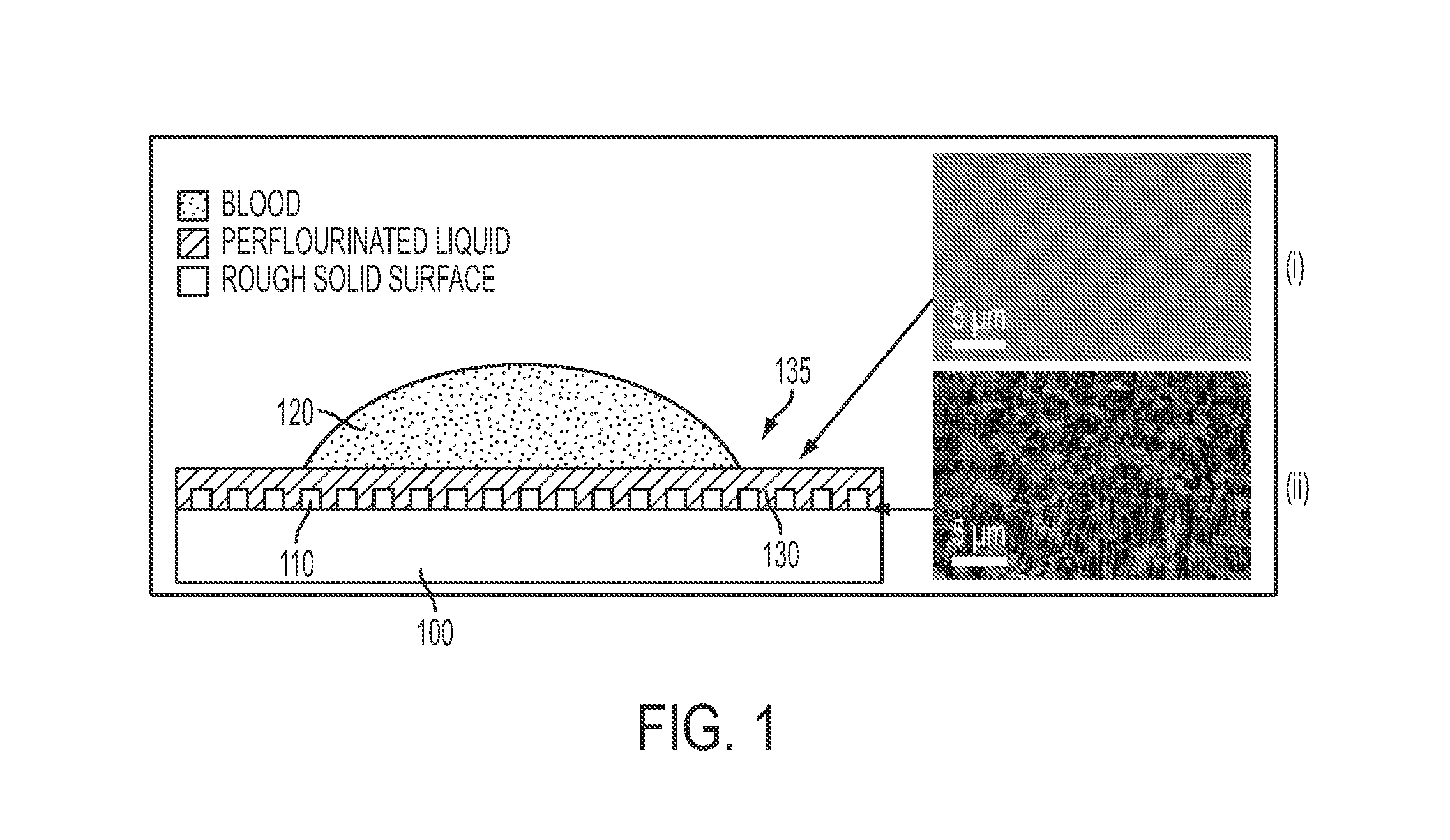Slippery liquid-infused porous surfaces and biological applications thereof
a technology of porous surfaces and liquids, applied in the field of surfaces, can solve the problems of limiting the applicability of liquids trapped within surface textures, unable to withstand pressure, and largely ineffective cushioning of trapped air against organic fluids or complex mixtures, so as to prevent inflammation, prevent plaque disposition, or foreign body response, the effect of preventing inflammation
- Summary
- Abstract
- Description
- Claims
- Application Information
AI Technical Summary
Benefits of technology
Problems solved by technology
Method used
Image
Examples
example 1
[0266]A set of SLIPS was fabricated to repel fluids spanning a broad range of surface tensions. To generate roughness, two types of porous solids were tested. The porous solids were periodically ordered and random: (i) arrays of nanoposts functionalized with a low-surface-energy polyfluoroalkyl silane, and (ii) a random network of Teflon nanofibres distributed throughout the bulk substrate (FIG. 17). Low-surface-tension perfluorinated liquids (e.g. FC-70, γB=17.1 mN / m; or Dupont™ Krytox® oils) that are non-volatile and immiscible with both aqueous and hydrocarbon phases and therefore able to form a stable, slippery interface with substrates (i.e., E1>0 and E2>0) for a variety of polar and non-polar liquids including water, acids and bases, alkanes, alcohols, and ketones (FIG. 15 and FIG. 17) were chosen for the lubricating fluid. The SLIPS were generated through liquid infiltration into the porous materials, which resulted in a homogeneous and nearly molecularly smooth surface with ...
example 2
[0268]The disclosed surfaces provide an ultra-smooth surface capable of preventing, reducing, or delaying surface wetting of fluids that come into contact with SLIPS.
[0269]An experiment was conducted in which the difference in surface adhesion of blood on PDMS was compared to that of an oil-infiltrated PTFE surface. 0.75 mL of fresh whole blood from a human subject was used, without the addition of heparin. The whole blood was pipetted onto four surfaces, one consisted of microstructured PTFE (Teflon; 1 μm pore size) impregnated with perfluorinated oil (FC-70), the second consisted of untreated microstructured PTFE which served as the control, the third surface was untreated glass, and the fourth surface was untreated PDMS. FIG. 11 shows sequential images of the blood sample being added to PDMS (FIG. 11A) and microstructured PTFE impregnated with perfluorinated oil (FIG. 11B). The surfaces made of PDMS (FIG. 11A), microstructured PTFE (FIG. 12D), and glass (FIG. 12A), all allowed th...
example 3
[0271]Experiments using 2 μm polystyrene particles showed that force of adhesion to slippery surfaces was extremely low, such that the particles were easily dragged by a fluid / air boundary interface across SLIPS, and concentrated into the center of a drying droplet instead of leaving a ‘coffee ring’ deposition.
PUM
| Property | Measurement | Unit |
|---|---|---|
| Density | aaaaa | aaaaa |
Abstract
Description
Claims
Application Information
 Login to View More
Login to View More - R&D
- Intellectual Property
- Life Sciences
- Materials
- Tech Scout
- Unparalleled Data Quality
- Higher Quality Content
- 60% Fewer Hallucinations
Browse by: Latest US Patents, China's latest patents, Technical Efficacy Thesaurus, Application Domain, Technology Topic, Popular Technical Reports.
© 2025 PatSnap. All rights reserved.Legal|Privacy policy|Modern Slavery Act Transparency Statement|Sitemap|About US| Contact US: help@patsnap.com



